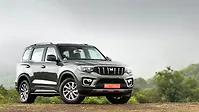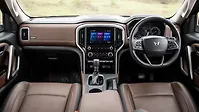Introduction

We recently embarked on a new journey. A journey to put the Automotive Journalists Association of India (AJAI) on firm footing. AJAI is a coming together of automotive journalists from the country to encourage and mentor young automotive journalists and offer support to the veterans of our industry.
This journey was the Bharat Drive wherein we drove the Mahindra Scorpio N across the country to celebrate the biggest democratic process in the world - our elections - as well as the largest, most significant infrastructure projects that have helped put India on the fast lane to progress.
Where and why?

Now, we are car people. So, we decided to celebrate infrastructure projects that have not only put India on the fast lane to progress but have helped with India's car culture in general. For this, we covered expressways, road bridges, tunnels, testing centres, and highways across India that have helped motoring in various forms.
We included tunnels that have cut out tediousness from road journeys while adding safety; expressways that have allowed us to stretch the legs of our modern cars without compromising on safety; and the test centres that have helped develop new cars and their modern systems for us to indulge in nicer driving dynamics.
Now, to cover it all, the team of 12 media partners including Auto X, Auto Today, Car India, Evo India, Motoring World, Overdrive, Powerdrift, The Print, Turbocharged, TOI Auto, ZigWheels, and of course, CarWale were split into three groups. Group 1 covered the north of India, Group 2 headed towards the northeast, and Group 3 went to Kanyakumari covering the southern part of our sub-continent. We, as CarWale, were slotted in the second group.
Group 2, leg 2
Group 2 covered 4,000km from Mumbai to Bomdila. The Mumbai to Indore leg was covered by our friends at Overdrive. This involved experiencing the brilliant Samruddhi Expressway.

I have been on the expressway before and it has completely transformed how one traverses Mumbai-Nagpur. It is fast, safe, and awe-inspiring. I remember the first time I drove from Mumbai to Nagpur as part of our Coast to Coast drive, wherein we were endeavouring to drive from Mumbai to Kolkata in the shortest time possible. This was 2006 or 2007, and we were doing it in sedans because SUVs weren't the craze then as they are today.
It was a challenging journey. Exciting, but challenging, nonetheless. There was no Samruddhi then, obviously, but there were also no four lanes for most parts, including parts of the Mumbai-Nashik route. We broke alloy wheels, got lost, and were stuck in epic jams. Today, thanks to expressways, four lanes, and ease of crossing state borders, one can cover the same distance in half the time, and without once scaring oneself silly.
Roads are only part of the reason for this. The other important part of this equation is the vehicles themselves. Take the Scorpio N we are driving for instance. It too has evolved sharply from its first iteration. Be its dynamic ability from cornering to straight-line stability, not to mention braking, steering response, and overall body control, it has all improved so dramatically, that one can't even begin comparing the two. Not surprisingly, road trips today are not just easier, but safer and more comfortable than before.

But to be able to develop such vehicles, hone them, and validate their abilities, one also needs state-of-the-art proving grounds. And we happened to drive to one of them as part of the second leg of the journey. To NATRAX, near Indore.
The highway leading to NATRAX from Indore is the same one that leads to Mumbai. As with most national highways across the country, this one too is a four-lane, clearly demarcated, reasonably well-surfaced one. Traffic is heavy on this route but not unruly. But, of course, as with most other highways, you will find some jokers coming the wrong way here too. So, do watch out for them.
NATRAX

NATRAX is India’s state-of-the-art testing and certification centre. This wasn't my first visit to NATRAX, though. And even as CarWale, we were here before the centre officially opened to have a go at the various tracks.

The showstopper for NATRAX is its high-speed bowl. I drove an AMG here earlier, flat-out, up on the banking, sitting there at close to 280kmph without even having to steer it around the banking. It was surreal.
Tracks explained

NATRAX claims cars can be tested at a mind-boggling speed of 375kmph at the high-speed track (HST)! Neutral speeds remain to be 250kmph on this oval-shaped track, which is 16m wide with five lanes and an additional service lane. OEMs can perform various tests here apart from top-speed runs. These include constant speed fuel consumption tests, coast-down tests, brake tests, speedometer calibration, and many more.

Besides HST, NATRAX also has a 3.6km-long dry handling circuit with varying gradients meant to help fine-tune the dynamics of a car. There’s a multi-friction braking pad to help improve tyres and tune ABS. NATRAX has a dynamic platform too which uses a 300m-diameter steering pad connected to the long stretches of approach roads that can test slalom, double lane change, and even J-turns.
These apart, NATRAX also offers torture tracks to test the robustness and build quality of vehicles. It is said that just 500km on these tracks equals driving a lakh kilometres around various road conditions across our country.

There’s a gradient track, an off-road track, and one to test the noise and comfort levels of a car as well. And these are just tracks; NATRAX also has a set of test laboratories on its premises. Needless to say, when it comes to vehicle testing, evaluation, and development, NATRAX seems to have it all covered.
What’s next?

Post-NATRAX, after we got off the Group 2 Scorpio train, it headed towards the Purvanchal expressway. The expressway is over 300km long and connects Lucknow to Ghazipur. Like most modern expressways, it is well-marked, well-surfaced, and six-laned. But its talking point is the built-in 3.2km airstrip. It has been included as part of the expressway to facilitate emergency landings of fighter planes.

Post Purvanchal, the two Scorpio Ns headed into the northeast and the Sela tunnel. The Sela tunnel is important because it ensures a year-long connectivity between Assam and Arunachal Pradesh; more specifically between the cities of Guwahati and Tawang. According to its makers, BRO or Border Road Organisation, this is the longest bi-lane or two-lane road tunnel in the world at an altitude above 13,000ft. It comprises two tunnels — measuring 0.9km and 1.5km — which are connected by a link road.
The end of the beginning
Having driven on and through the Mumbai-Nagpur expressway, NATRAX, Purvanchal expressway, and the Sela Tunnel, Group 2 journey came to an end. As did the journeys of Groups 1 and 3.
It was a revelation of how far our country's infrastructure has progressed. Plus, how it is encouraging more of us to get into our cars and explore our country even more. But, although our journey with the Scorpio N ended, the journey to build, establish, and grow AJAI or the Automotive Journalist Association of India is just beginning.
Just to reiterate — AJAI is a coming together of automotive journalists from the country to encourage and mentor not just young automotive writers, but also presenters, DOPs, and technicians, while also providing support to the veterans of our industry.































